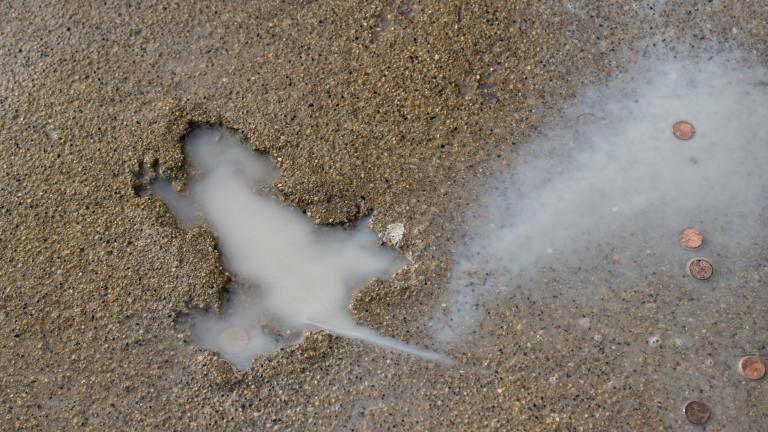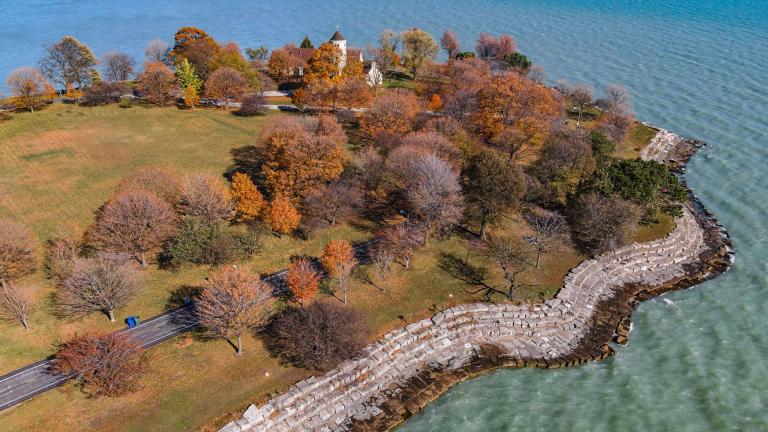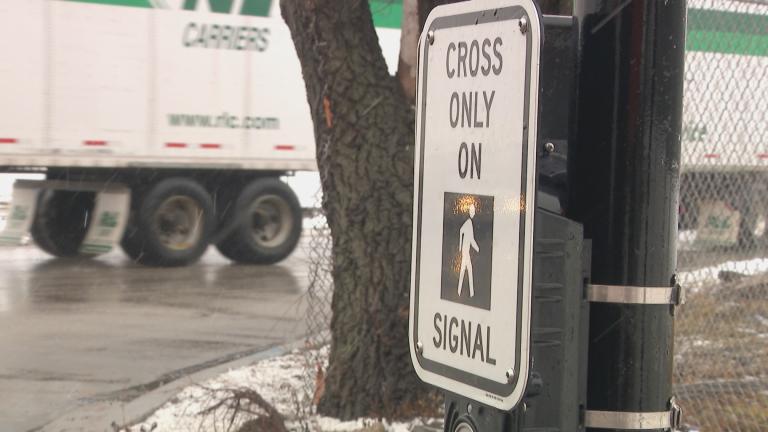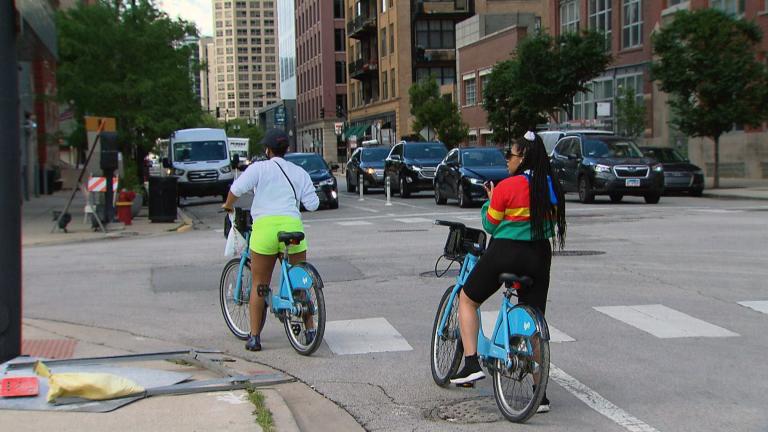Like many Chicago residents, Adam Ballard enjoys the convenience his neighborhood provides. He’s able to catch a movie or watch the Chicago Fire play just a short distance from where he lives.
“My preferred mode of transit is my own chair,” Ballard said. “There’s a good chunk of stuff that I can do in my own chair, as long as I have sidewalks to help me get around.”
Ballard, who was born with a joint condition that led to him using the chair full-time since college, gets around his Pilsen neighborhood with a power wheelchair. The 43-year-old said he also enjoys rolling through different neighborhoods in the city when the weather gets nice.
“Sidewalks are super important to me,” Ballard said. “It just makes it frustrating when there are gaps in that network that make it less of a viable choice.”
 Adam Ballard is pictured on a cracked sidewalk in front of a beauty salon near his Pilsen home. (Michael Izquierdo / WTTW News)
Adam Ballard is pictured on a cracked sidewalk in front of a beauty salon near his Pilsen home. (Michael Izquierdo / WTTW News)
Ballard works downtown and sees sidewalks in various states of disrepair throughout Chicago. He said conditions at times have required him to call paratransit or cabs in place of public transit. Damage sometimes requires him to use the street in order to get to his destination, often without the protection of a bike lane, he said. That can present dangers.
Ballard was crossing Halsted Street early in the pandemic when sidewalk conditions forced him into the pedestrian crossing from the street, where a car clipped the side of his chair, he said.
Following the incident, Ballard has received treatment for swelling issues in his foot. “It’s going to probably be a chronic issue for the rest of my life,” he said about his health following the collision.
Sidewalk disrepair is hardly limited to Ballard’s neighborhood.
Gaps in coverage and stretches of difficult terrain can be found across the entirety of Chicago, impacting people with mobility or vision conditions, those pushing strollers, the elderly and residents accessing transportation and transit.
Sidewalk damage is the result of a variety of factors, including weather, wear and tear from normal use and impact from trees and other vegetation. How and when that damage is addressed is not as straightforward as it may seem.
The city uses a patchwork of programs to maintain its sidewalks. The responsibility is split between residents, the Chicago Department of Transportation and local ward offices.
To better understand how and where sidewalks across the city get repaired, WTTW News examined data, permits and repair records and spoke with those affected by poor conditions about how sidewalks are kept in shape and what they say should be improved.
Through that analysis, it became clear that a reliance on complaints to flag needed sidewalk repairs can create greater awareness of sidewalk problems in some North Side communities than in other areas of the city. Money is also easier to find for street projects, causing many to call for greater funding for the most widely used transportation routes in the city: sidewalks.
 Adam Ballard rides through the street on his electric wheelchair to avoid an inaccessible sidewalk near his Pilsen residence. (Michael Izquierdo / WTTW News)
Adam Ballard rides through the street on his electric wheelchair to avoid an inaccessible sidewalk near his Pilsen residence. (Michael Izquierdo / WTTW News)
‘Even Though It’s Owned by the City’
Up in Wicker Park, it’s difficult to encounter the sidewalk on the south side of West Pierce Avenue and not see it as a hazard.
It’s uneven with massive cracks stretching across its face. Parts of the sidewalk crater below as it folds into itself with a highly uneven surface that resembles a jagged skate park ramp more than a flat walkway. Neighbors, government officials and departments in the area all know about the condition of the sidewalk on this block.
Records show 10 inspection requests at a home on West Pierce Avenue west of Ashland Avenue through the city’s 311 service since 2020. But viewers across the country became familiar with the condition of this sidewalk during the first season of “Windy City Rehab” on HGTV in 2019.
Host Alison Victoria rehabbed this 1885 home on the popular show. In the first scene of the episode, she described the original details of the fire-damaged property while listing off necessary repairs that included, “the new sidewalk that we would be responsible for even though it’s owned by the city.”
 A sidewalk in front of a home on West Pierce Avenue in the Wicker Park neighborhood has had 10 inspection requests made through 311. (Jared Rutecki / WTTW News)
A sidewalk in front of a home on West Pierce Avenue in the Wicker Park neighborhood has had 10 inspection requests made through 311. (Jared Rutecki / WTTW News)
Records from CDOT show an inspection on the sidewalk in 2020, and said a project that repaired and replaced a “tripping hazard” closed in 2021, though the exact scope of that work and from the HGTV project is unclear. Another inspection request came eight months after the repair was closed, records show.
The sidewalks in this part of the city are vaulted, which is also common in neighborhoods like Bridgeport, Wicker Park and Pilsen. These types of sidewalks were built after the city was elevated to install a sewer system in the mid-1800s to decrease flooding. Recent city capital plans budgeted about $1 million per year to repair and replace vaulted sidewalks, records show.
According to the latest capital plan, the city performed 20 vaulted sidewalk repairs between January 2021 and June 2022. Repairs are selected through 311 complaints and inspections, according to the city.
Another sidewalk in Roscoe Village on Wolcott Avenue in front of an apartment building had a three-inch gap between the alley and the sidewalk with a damaged curb cut. It also has large cracks, and was nearly ground to gravel in spots in April.
Residents requested an inspection 15 times for this sidewalk, which isn’t vaulted, since 2021, records show. But records from the city also show it had not been repaired during that time. The property next door had three service requests during the same period, and was recently repaired by the local ward office. Repairs blocked that sidewalk for the entire month of March, according to neighbors.
 A sidewalk in Roscoe Village on Wolcott Avenue has been the source of 15 inspection requests since 2021. A permit to replace it is in progress as of April 2024. (Jared Rutecki / WTTW News)
A sidewalk in Roscoe Village on Wolcott Avenue has been the source of 15 inspection requests since 2021. A permit to replace it is in progress as of April 2024. (Jared Rutecki / WTTW News)
Records from CDOT show the sidewalk in Wicker Park is scheduled to be repaired this construction season, and a permit in Roscoe Village to remove and replace the sidewalk shows work in progress.
Shared Cost Program
Chicago, like many other municipalities, offers a shared cost sidewalk program, which allows residents to split the payment for repair with the city. The city has repaired more than 9,500 sidewalks in the public right-of-way under this program since 2013, records show. CDOT estimated the annual cost of the program at about $4 million.
Applications opened on Jan. 8 this year, and slots were filled almost immediately. In most years, the initiative is open for a day or two before the slots fill up and many applicants are denied access to the oversubscribed program.
The city says the cost for homeowners is below that of private contractor rates for sidewalk repairs. Senior citizens and people with disabilities may also qualify for a 50% discounted rate.
CDOT surveys the area to determine if repairs are needed, as well as the scope and cost of reconstruction. If CDOT determines the location is eligible for the shared cost program, an estimate is sent to the property owner.
Payment must be made in full in order for the work to be scheduled. The construction season runs from June through December, and if the payment is made too late in the year, the work will be scheduled for the following year.
The city estimated the approximate cost to a property owner of an average mid-block property will range from $600 to $1,500 with additional costs for corner lots, below what a private contractor would charge. Vaulted sidewalks are ineligible for the program.
An analysis of city data by WTTW News shows highest usage of the shared cost program in Norwood Park, West Ridge and Beverly. Community areas on the North Side use the program more than the South and West sides, records show.
Sidewalk coverage varies between community areas. The Far South Side has fewer sidewalks in the industrial areas of Hegewisch, South Deering, Pullman, Riverdale and East Side, according to a study by the Chicago Metropolitan Agency for Planning. There are also fewer sidewalks in Jefferson Park, Forest Glen, Norwood Park, Edison Park and North Park because of adjacent forest preserves.
CDOT estimates there are approximately 7,420 miles of sidewalk within the city of Chicago, and said it relies on public reporting of sidewalk repairs and inspection requests through 311 to monitor conditions.
Ald. Anthony Napolitano, whose 41st Ward includes parts of Norwood Park, said his office prioritizes helping local residents sign up for the shared cost program in addition to recommending they send complaints through the 311 system. Norwood Park had a city high of almost 800 shared cost repairs in the past decade, according to an analysis of data from the city.
“We promote the heck out of the program,” Napolitano said. “We try to get everybody signed up for it because our sidewalks are completely destroyed up here.”
Napolitano said he thought the city should pay for sidewalk repairs when he first came to office, but his mind changed in favor of the shared cost program when he saw how resources were being spent in some places rather than across the whole city.
“I got into office and realized how mismanaged the city has been for so many years on their budgets, allocating funds towards projects instead of infrastructure for so many years,” Napolitano said.
Researcher Jesus Barajas of the University of California-Davis explored data from the Chicago shared cost program for a 2021 conference presentation.
He reported a correlation between larger shares of White residents and the number of project requests. There is money going to disadvantaged communities, but more people are requesting repairs in wealthier areas, he found.
Barajas also connected more multifamily rentals in an area to a lower number of service requests.
Though they represent a small share of overall work, data from the city show the top 17 community areas with the highest percentage of shared cost repairs discounted for seniors and those with disabilities are located on the South and West sides.
Records from the city indicate a quarter of approved repairs where senior or disability discounts were granted for the shared cost program in 2023.
Complaint data geography for sidewalks tracks with a March report by the Office of the Inspector General, which found Chicago was overly reliant on 311 requests for service, leading to higher long-term costs, safety risks and inequities in service delivery across neighborhoods.
Many interviewed for the story pointed to a lack of coordination between city agencies and utilities as a cause of inefficiency in repairing and replacing sidewalks.
Ald. Daniel La Spata (1st Ward) said Chicago still could do a better job maintaining its sidewalks, especially for those with accessibility needs.
La Spata, who is the chair of the Committee on Traffic and Pedestrian Safety, also said in an interview the city could benefit by expanding beyond its current complaint-based model of service.
“I think grid-based surveying of our sidewalks makes a lot of sense. It does necessitate a serious conversation around how we fund capital and infrastructure in the city of Chicago,” La Spata said. “To keep our sidewalks in the condition that all Chicagoans deserve would take substantially more funding.”
CDOT said it surveys thousands of sidewalk locations each year, but the department does not have enough data to accurately say how many miles of broken or damaged sidewalks currently exist in Chicago.
La Spata highlighted how the city could prioritize repairs in neighborhoods based upon factors including income and mobility issues.
“It’s one thing if you’re making roughly $140,000 a year working as an elected official,” La Spata said about shared cost repairs. “If I was making $30,000 a year, that cost feels a lot higher.”
Kate Lowe, an associate professor focused on transportation at the University of Illinois Chicago College of Urban Planning and Public Affairs, echoed the feelings of many others interviewed for this story when she talked about a nationwide emphasis on funding road projects at the expense of sidewalks. She said shared cost programs benefit some communities more than others.
“Any program that requires matching funds on the part of the individual household has some regressive features because no matter what the need is, if private property owners are too fiscally stressed to pay for half, then they’re left out,” Lowe said.
Chicago was impacted by a quarry strike and a cement shortage in 2022 that delayed many sidewalk and road projects. The lowest total for shared cost repairs over the past decade in the city was in 2022, records show.
According to Laura Saltzman, senior policy analyst for the disability advocacy organization Access Living, sidewalk accessibility is a constant problem in Chicago for people with disabilities. Broken sidewalks and lack of curb ramps make parts of the city inaccessible for many, she said. She also highlighted how the shared cost model is absent from a number of other important city programs.
“There is no shared cost street repair program,” Saltzman said. “There’s no shared cost elevator repair program.”
Saltzman said sidewalk conditions are worse in some areas than others, but there are problems in almost every neighborhood.
“The city needs to take responsibility,” Saltzman said. “It needs to just be fixed.”
When asked about the disparities in the shared cost program, a spokesperson said, “Recognizing that not every homeowner may choose to or be able to participate, CDOT makes sidewalk repairs through several other programs that do not require any payment from adjacent property owners.”
Sidewalks came up during the March confirmation hearing for CDOT Commissioner Tom Carney, who answered questions about the shared cost program and the city commitment to ADA compliance. When asked about priorities centered around those with disabilities and seniors, Carney said, “We are committed to that.”
 A sidewalk pulls apart in the 2800 block of South Komensky Avenue in South Lawndale. (Jared Rutecki / WTTW News)
A sidewalk pulls apart in the 2800 block of South Komensky Avenue in South Lawndale. (Jared Rutecki / WTTW News)
The Menu of Repair Programs
Chicago has other sidewalk repair programs, too. The hazardous repair program fixes tripping risks on the city right-of-way. The city requested $3 million per year for hazardous repairs in the budget, records show.
The number of hazardous sidewalk repairs is comparable to the number of shared cost repairs most years, according to records from the city. Communities with lower household income see more repairs under the hazardous repair program than shared cost, but the geography shares similar characteristics with greater use in higher-income communities.
Hazardous repair totals are affected by the size of community areas, density and land use, according to CDOT.
CDOT said it prioritizes sidewalk repair projects based on condition assessments, duration of time in the 311 system and coordinates by geographic area within wards to be efficient. All wards are serviced each year.
Other programs addressing sidewalks include ADA polling place access, underpass and viaduct repairs, arterial and residential resurfacing, and the Works Progress Administration Streets Replacement program.
The city has also focused resources on installing sidewalk ramps that comply with the Americans with Disabilities Act following a $50 million settlement in 2007. CDOT’s streetscape and street reconstruction projects include installation of new, often wider sidewalks on project corridors.
Beyond the aforementioned funds from local government and city residents, other local and federal money comes from sources including the Rapid Transit Authority, Chicago Metropolitan Agency for Planning, Cook County and the U.S. Department of Transportation.
Kyle Lucas works with Better Streets Chicago, a transportation advocacy organization. Lucas was optimistic about the city being able to fund sidewalk improvement projects.
“It really comes down to us making it a priority and then following up with action and the funding,” Lucas said. Those priorities may be revealed when City Hall passes a new capital plan in the fall.
Lucas echoed the problems described by other advocates and city leaders about the lack of efficiency in how Chicago coordinates repairs, and the length of time some projects take to complete.
“Another really frustrating thing which ties into a larger problem with Chicago street work and utility work is the lack of departmental coordination, and coordination with utility companies,” Lucas said.
When the city fails to maintain its sidewalks, local leaders can also take the matter into their own hands.
Every year, Chicago distributes menu money to members of City Council to spend at their discretion on capital improvements in their wards. The funds can be used for projects that include paving roads, pedestrian safety projects, street lighting, traffic calming and sidewalks.
Before 2021, each ward received $1.32 million per year to spend on projects. The amount later increased to $1.5 million per year. Records show more than $84 million in expenditures across the city since 2013 for sidewalk repairs under this program.
Sidewalk locations that are eligible for the shared cost program are tracked as potential options for alderpeople to select as future menu locations, according to CDOT.
CDOT said its collector street program supplements the menu program in the maintenance of residential streets. CDOT factors in pavement condition, ADA accessibility, and mobility and economic factors.
The program provides additional miles of resurfacing, coupled with sidewalk and curb and gutter improvements where needed. Since the program started in the summer of 2021, more than 5,000 ADA ramps have been improved.
There are huge differences in the amount spent on sidewalk projects in each ward, reflecting the different conditions and needs of each community.
The highest expenditure between 2012 and 2023 was in the 14th Ward, led until recently by long-tenured former Ald. Ed Burke, who was convicted of racketeering, bribery and extortion in December. The ward, currently led by Ald. Jeylu Gutierrez, spent almost $6 million on sidewalk repairs through the menu money program, according to data compiled by a local policy researcher.
The 19th Ward, by contrast, spent $8,051.56 during the same time. Beverly and Mount Greenwood, which are part of this ward, had the highest repair totals under the shared cost program since 2013 on the South Side, records show, in contrast to the menu money total.
WTTW News’ Nick Blumberg contributed to this report.
Contact Jared Rutecki: @JaredRutecki | [email protected]







